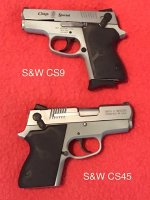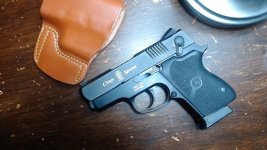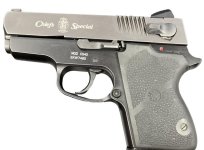A couple weeks ago I went into a LGS looking to see if they had a 5" Springfield Armory Prodigy I was curious about but found a black CS40C in their used gun section instead. 
Don't recall every coming across any CS40s before locally. This one came with two magazines & the factory box with the typical papers inside it.
Had a bunch of holster wear on the muzzle but a quick field stripping showed no noticeable wear on the rails or frame, lightly dirty & lubed.
The price was right so I brought it home.
It's EKW75xx serial number dates to Oct-1998.
Gave it a thorough inspection/cleaning/lube replacing a few consumable parts as needed.
The sideplate required removal & some straightening before re-installation.
These are actually 3.25" barrels but they're commonly called 3" barrels. (Kind of like the 4516s are actually 3.75" barrels but everybody calls them 3.5"). Actual rifled barrel length is 2.4", chamber shoulder to muzzle.
Chamfered the muzzle to give the rifling better presentation as it was uneven.
One thing I noticed is that the barrel does not have any freebore cut into it, unlike all my other 3rd Gens. The rifling tapers down to the leade at the chamber's shoulder but it lacks the smooth freebore typically cut out ~0.100" forward of the shoulder.
Anybody else notice this on theirs?
I've always loaded all of my 40 S&W handloads to 1.135", SAAMI max COAL", without issues, but most bullets won't pass the plunk test in this barrel because of the lack of freebore necessitating a shorter COAL" & a powder charge adjustment in it's ammo.
I loaded about (80) rounds of moderate handloads, with their COAL" adjusted accordingly, to range test in it. All shot well with no malfunctions. The 155gr XTPs grouped the best in my brief comparison.
My range trip was originally planned to chrono test some 45WSM & 45 Colt loads but I also passed some of the CS40's handloads thru the LabRadar beam as well & was pleased with their performance.
I have a Dave Manson .40 throater on the way so the next item on the agenda will be to add some freebore to the CS40's barrel so my existing handloads can properly plunk.
.

.
.

.
.

.
.
-the chrono readings are in blue green on the right-
.

.
Don't recall every coming across any CS40s before locally. This one came with two magazines & the factory box with the typical papers inside it.
Had a bunch of holster wear on the muzzle but a quick field stripping showed no noticeable wear on the rails or frame, lightly dirty & lubed.
The price was right so I brought it home.
It's EKW75xx serial number dates to Oct-1998.
Gave it a thorough inspection/cleaning/lube replacing a few consumable parts as needed.
The sideplate required removal & some straightening before re-installation.
These are actually 3.25" barrels but they're commonly called 3" barrels. (Kind of like the 4516s are actually 3.75" barrels but everybody calls them 3.5"). Actual rifled barrel length is 2.4", chamber shoulder to muzzle.
Chamfered the muzzle to give the rifling better presentation as it was uneven.
One thing I noticed is that the barrel does not have any freebore cut into it, unlike all my other 3rd Gens. The rifling tapers down to the leade at the chamber's shoulder but it lacks the smooth freebore typically cut out ~0.100" forward of the shoulder.
Anybody else notice this on theirs?
I've always loaded all of my 40 S&W handloads to 1.135", SAAMI max COAL", without issues, but most bullets won't pass the plunk test in this barrel because of the lack of freebore necessitating a shorter COAL" & a powder charge adjustment in it's ammo.
I loaded about (80) rounds of moderate handloads, with their COAL" adjusted accordingly, to range test in it. All shot well with no malfunctions. The 155gr XTPs grouped the best in my brief comparison.
My range trip was originally planned to chrono test some 45WSM & 45 Colt loads but I also passed some of the CS40's handloads thru the LabRadar beam as well & was pleased with their performance.
I have a Dave Manson .40 throater on the way so the next item on the agenda will be to add some freebore to the CS40's barrel so my existing handloads can properly plunk.
.

.
.

.
.

.
.
-the chrono readings are in blue green on the right-
.

.
Last edited:




















